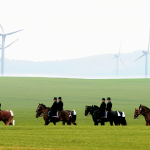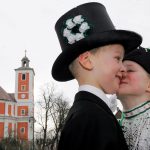Nebelschütz, Saxony, Germany
Nebelschütz, which lies in Oberlausitz, has 440 inhabitants and is part of the municipality with the same name that embraces a territory of 22.9 km² where approx. 1,300 people live, 80 percent of which are catholic. Since 1990 the number of inhabitants has risen minimally, the unemployment rate is twelve percent.
Nebelschütz together with its four neighbouring municipalities forms the core of the settlement area of the Sorbian people. Approx. two thirds of the inhabitants are bilingual. This characteristic of an amicable cooperation of both languages and cultures is present in everyday life and gives the region its unmistakable identity. A strength of which they are aware and want to maintain in the future and take economic advantage of.
Nebelschütz started its development process to renew the village in 2000 by expanding and developing former barracks. Today they form the village centre with the municipal council and accommodate a library with internet café, a hairdresser, an exhibition room, an event hall and a shop; the “Krabat” shop where local specialities such as “Krabat” liqueur can be bought. Also the Nebelschütz youth club, the sport association and the voluntary fire brigade are located in the village centre.
Taking advantage of the general tourist upsurge in Oberlausitz with its comprehensive cultural offerings and charming pond area Nebelschütz has developed its own special label; the “Krabat”. They very cleverly linked the old story of the Sorbian magician “Krabat” with contemporary tourist and development strategies.
In an effort to conserve old buildings the ensemble “Krabathof” was created, consisting of the “Heldhaus” that was renovated true to the original timber-framed style and built as a youth hostel, the wooden “Wendentor” with dovecot that brings traditional Sorbian handwork and farming tradition to mind, and the parish centre „Bjesada“ (the Sorbian word for “place for discussions”) that was erected in an ideally renovated old barn and today serves as a place for festivals and large events.
In the bio-solar and industrial estate in „Krabatstein“ a production cooperative for renewable resources has been developing since 2007 a concept for the production of innovative products such as clay building panels and pellets. An already installed large scale solar plant on the roof of the production hall will deliver the energy. In addition the bio-gas plant will be expanded to include a pig breeding plant.
The upgrading of a four sided farm building in the centre of the village had a positive effect on the development of settlement and the economical situation. As a service provider and tradesman courtyard it offers room to several companies including an electrical company with 50 employees. In addition eight flats were created.
Miscellaneous recyclable material is collected in the communal construction and recycling courtyard, a former large scale cow barn, professionally stored and then made available at a reasonable price as construction material for renovations . In front of the building yard an ecological garden is being built in painstaking detailed work as a learn and play garden for the children of the day care.
The motto „Future through social innovation“ is being fulfilled by Nebelschütz to a high degree with its efforts to preserve the identity of the Sorbian people and to support them as a minority. This is contributed to by many clubs that maintain Sorbian conventions, customs and culture and support and practice bilingualism. In addition international municipal festivals, youth festivals and artist symposia make an important contribution to international understanding.
Nebelschütz impresses with it initiatives to preserve and expand job possibilities, its responsible handling of resources, the revitalisation of old buildings worthy of preservation, the creation of material and energy cycles, the value laid on the Sorbian tradition as a stand alone tourist feature, the cohesion in the village community and with partnerships in the whole world which has made it a world open village with a future.
Evaluated: 2008



